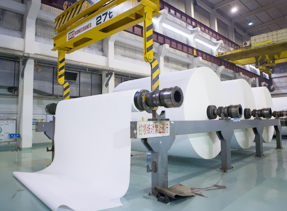0086-371-67986516

Pulp & Paper Wastewater Treatment
The pulp and paper industry is constantly evolving and is faced with growing environmental opposition and constraints. This means that it has to look for ways of making significant improvements to areas such as the water cycle, which affects production quality and productivity, while complying with stringent regulatory constraints.
The pulp and paper industry uses large amounts of water (pulp preparation and bleaching water, boiler feed water and cooling system water) and subsequently has to treat significant volumes of wastewater and sludge. Therefore effective water management (including streamlined consumption and recycling) can have a direct effect on the plant’s production, performance and environmental impact.
P&P waste streams include effluent solids, sediments, absorbable organic halides (AOX), chlorinated organic compounds, and chemical oxygen demand (COD) and biological oxygen demand (BOD) contaminants. Approximately 85% of the water used in the P&P industry is used as process water, resulting in relatively large quantities of contaminated water and necessitating the use of onsite wastewater treatment solutions. Treatment options include primary treatment such as clarification to remove solids and particulate matter, and secondary biological treatment processes for removing biodegradable organic matter and decreasing the effluent toxicity.
Additionally, tertiary treatment technologies such as membrane filtration, UV disinfection, ion exchange, and granular activated carbon can also be employed to further treat effluent water to higher qualities.
Paper is produced from “new” or recycled pulp. Depending on the quality of pulp, it’s used for different sorts of paper. During the process of paper producing, kaolin, CaCO3, talc and/or TiO2 are added to the pulp, to give the paper whiter color.
Also chemicals like organic fillers (starch, latex), colors, aluminum sulfate, etc. are used to make paper of different properties or making the process simpler.
Paper can be decolored, which can be done with two different processes. Washing the pulp with a high amount of water or washing with a low amount of water plus additions like sodium silicates, sodium carbonate, fatty acids or non ion detergents.
The treatment of waste water and sludge:
• By a physical/chemical finishing process, for the reduction of suspended matter and phosphorus
• By biological pre-treatment to eliminate carbonaceous pollution
• By biological process for diluted effluent and high water flow
• By a methanisation process, for granular sludge and to make use of the energy contained in the sludge
• By MBR, combining aerobic digestion with separation by ultrafiltration membranes
Anaerobic Digester Processes
Biological treatment has for some time been state of the art for effluent treatment but as energy costs are soaring new ways of minimizing treatment costs are sought. Increased water reuse by closing up water circuits without ruining the quality of final products is an important aspect. Pretreatment of selected process streams prior to external treatment will in many cases be beneficial from both cost and environmental points of view.
Anaerobic treatment of paper mill waste water,in anaerobic conditions, through the role of anaerobic bacteria, so that water molecules in the degradation of organic matter to produce biogas and a small part of the small material (sludge). Papermaking wastewater after flocculation, primary sedimentation, balanced and modulated in the upflow anaerobic reactor conversion reaction occurs, get 85% of the energy in the form of methane, and then to heat or electricity in the form of recycling.
In aerobic wastewater process, a large number of aerobic micro-organisms are placed in the sewage treatment plant, so a large number of pollutants in these organisms become food. Because these microorganisms are aerobic type, in handling the device must provide adequate oxygen. Aerobic treatment is the role of bacteria and protozoa, these microorganisms transform organic contaminants into CO2, H2O, energy and the new micro-material (sludge).
Advanced Treatment by Chemical Oxidation of Pulp and Paper Effluent from a Plant Manufacturing Hardboard from Waste Paper
In the first step, a chemically assisted settling was applied. The optimum results were obtained with alum plus lime with the alum dose of 200 mg l-1. In the second step, chemically assisted settling effluent was fed into an activated sludge system and over 80% COD removal was achieved.
Treatment of Pulp and Paper Mill Wastewater by Polyacrylamide (PAM) in Polymer Induced Flocculation
The Flocculation performances of nine cationic and anionic polyacrylamides with different molecular weights and different charge densities in the treatment of pulp and paper mill wastewater have been studied. Cationic polyacrlyamide with very high molecular weight and low charge density is found to give the highest flocculation efficiency in the treatment of the paper mill wastewater. the use of the polyacrylamides is economically feasible to treat the pulp and paper mill wastewaters.
flocculation tank and the primary settling tank to remove solids. Flocculation tank mixed with a fast pool and two flocculation mixing tank, the sewage by gravity into the vicinity of the primary settling tank; in the primary settling tank, solids separated from wastewater, and is around the machine scrape off mud scraper bucket, longer rely on gravity into the back of sludge treatment system, a switch by the time-control valve to control the emissions of primary sludge.
Furthermore, we offer a full range of services and chemicals to meet any requirements;
we have a broad range of experience creating customized water solutions for the pulp and paper industry including:
• Wastewater treatment
• Boiler and cooling water treatment
• Process water treatment
• Pre-treatment
• Influent and effluent water treatment
• Proprietary chemistries
No matter what your pulp and paper industry challenge is,hoo chemtec can help.
Hoo chemtec creates leading edge pulp and paper industry process solutions andspecialty chemical blends including: biocides, corrosion inhibitors, defoamers, odor control, polymers, retention and drainage aids, and wet and dry strength agents.